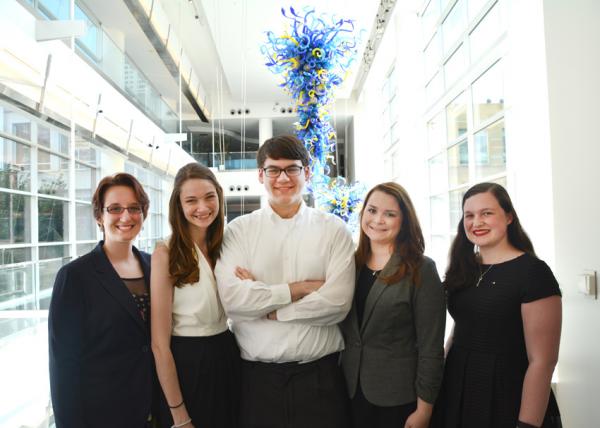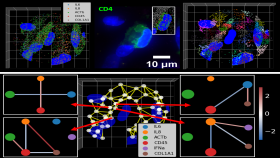In May, sixty biomedical engineering (BME) students from Georgia Tech flew to Galway, Ireland to earn course credit and get exposed to international biomedical device manufacturing. A product design from one of the BME classes was recently selected as a world-wide finalist in UNICEF’s Wearables for Good Challenge. The team, Communic-AID, developed a wearable device that facilitates record keeping, aids in the tracking of medications that have been distributed in a post-disaster context and allows the patient to take part in their treatment. The BME student project team members are Katie Fiedler, William Higgins, Heather Issen, Madison Lewis, and Isabelle Vernon.
Their device is a wearable wristband with NFC communication technology that stores emergency medical information for individual patients. Medical professionals can access this information, load updated records onto the device, and set alerts to facilitate the patient's care such as alerting them when to take medication. The band is worn by the patient on the wrist (or ankle), and the app is used by the medical professional.
The United Nations Children's Fund (UNICEF) is a United Nations program headquartered in New York City that provides long-term humanitarian and developmental assistance to children and mothers in developing countries. UNICEF’s Wearables for Good contest challenges innovators to design wearable and sensor technology that serves people in resource constrained environments. The Wearables for Good challenge is open to anybody with ideas, including students, entrepreneurs, members of the maker community, engineers, designers, and technologists.
The catalyst for the team’s project arose from an experience broadening summer program which is a collaboration between the Wallace H. Coulter Department of Biomedical Engineering at Georgia Tech and Emory, and the National University of Ireland, Galway. The program is designed for third and fourth year BME students who are interested in an international experience which enables them to combine classroom learning with field trips to medical device companies to learn first-hand about their research, development, and manufacturing practices. Students complete roughly four courses from May 25 to July 31.
One of the unique courses offered is Wearables for Healthcare (BMED 4823) taught by Raja Schaar. Schaar, a design instructor in the Coulter Department of Biomedical Engineering, said, “Wearables are the next hot thing in healthcare. Fitness trackers and smart watches have taken off in the market. With the advances in hardware, miniaturization, and the emergence of the Internet of Things, technology is catching up to our aspirations.”
Technology is at a point where real-time health information is empowering consumers to be stewards of their own health as well as providing health care providers and researchers much needed insight into the lives of their patients. Useful wearables are now possible because companies are able to combine miniaturized sensors and cheap reliable power with advanced connectivity and big data analytics.
In computing and design programs there has been a big push to marry digital and physical devices, but Schaar did not find a course focused on healthcare wearables out there. Schaar added, “Healthcare presents unique challenges related to regulatory compliance, privacy, and security. This is a fast-moving field, and as opportunities in bioinformatics, telehealth, and device development present themselves, our students need to be positioned to compete and contribute.”
During the first week of her course, students think about electronics on the body and create quick on-body electronic devices in the spirit of Chindogu. Chindogu is the Japanese art of inventing ingenious everyday gadgets that, on the face of it, seem like a solution to a particular problem. However, chindogu has a distinctive feature: anyone actually attempting to use one of these inventions would find that it causes so many new problems, or such significant social embarrassment, that effectively it has no utility whatsoever. Thus, chindogu devices are sometimes described as "unuseless" – that is, they cannot be regarded as "useless" in an absolute sense, since they do actually solve a problem; however, in practical terms, they cannot positively be called "useful.”
Week two involves studying microcontrollers, processing, and biosensors. Students participate in the Unicef Wearables for Good Challenge during the final three weeks. The goal is to develop innovative, affordable solutions to make wearables and sensor technology a game-changer for women and children across the world. This summer, students ended up with promising ideas such as devices that address air pollution, child trafficking, breastfeeding, maternal prenatal anemia, biometric screening, water transportation and filtration, and medication compliance and tracking.
In addition to the sixty students, seven BME faculty members taught classes and led field trips. The west side of Ireland has become the European capital for the healthcare and medical device industries. The majority of the companies (e.g. Medtronic, Boston Scientific, Cook Medical, Abbott, etc.) are international. Some of the company field trip visits included Medtronic, Visktakon, and Cook Medical. Located in Limerick, Cook Medical is a maker of catheters, stents, and drug coated stents. On this tour, students saw the handling of raw materials, incoming quality control, a controlled manufacturing area, finish quality control [including destructive testing with samples of each lot], post-sterilization, and batch release.
In the spring of 2016, sign up for the next summer BME study abroad to the National University of Ireland, Galway will begin.
BME student Joy Janku said, ”wearables was one of my favorite classes taken at Georgia Tech. We gained a lot of interactive product experience by being exposed to tools like Littlebits and Arduino, and were provided with high quality 3D printers that everyone was able to get hands on experience with to bring our products to life. Secondly, and more importantly to me, we were asked to design for those in need by participating in the UNICEF Challenge which made the project feel that much more tangible.”
The Georgia Tech Communic-AID team submitted their idea to this global technology challenge and are now one of ten global UNICEF team finalists. More than 250 submissions from 46 countries across 6 continents entered the contest. Winners of this global wearable technology contest will be announced November, 2015.
UNICEF interviews Raja Schaar: Why budding designers should keep social impact in mind when designing
CONTACT:
Walter Rich
Communications Manager
Wallace H. Coulter Department of Biomedical Engineering
Georgia Institute of Technology
Media Contact
Communications Manager
Wallace H. Coulter Department of Biomedical Engineering
Georgia Institute of Technology
Latest BME News
Courses in the Wallace H. Coulter Department of Biomedical Engineering are being reformatted to incorporate AI and machine learning so students are prepared for a data-driven biotech sector.
Influenced by her mother's journey in engineering, Sriya Surapaneni hopes to inspire other young women in the field.
Coulter BME Professor Earns Tenure, Eyes Future of Innovation in Health and Medicine
The grant will fund the development of cutting-edge technology that could detect colorectal cancer through a simple breath test
The surgical support device landed Coulter BME its 4th consecutive win for the College of Engineering competition.
New research from Georgia Tech helps doctors predict how therapies will interact with a child's immune system, potentially improving outcomes and reducing risks.
Georgia Tech researchers reveal the dynamic role of inhibitory neurons in spatial memory and learning








